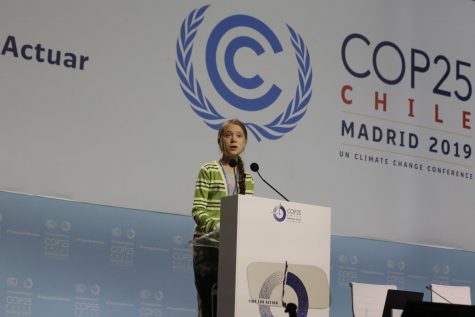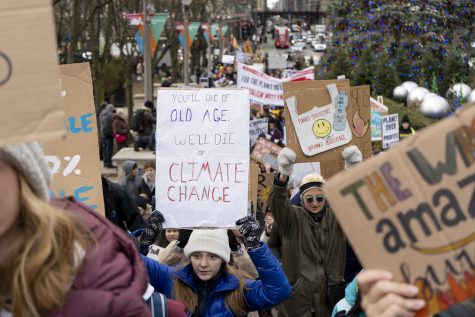Chronicle FYI: Where the world stands on the climate crisis ahead of 2020
December 16, 2019

Greta Thunberg, a Swedish climate activist, addresses world leaders at the COP25 summit in Madrid, Wednesday, Dec. 11.
As the decade closes, more than 25,000 leaders gathered for the 25th Conference of the Parties to decide the fate of new environmental policies in the midst of a global climate crisis.
2020 will mark one decade until the effects of the climate crisis become irreversible, and multiple pieces of environmental legislation have goals set for the coming year.
With this in mind, the Chronicle evaluates some indicators of where the world stands on the climate crisis in 2019:
COP25
The year came to a close with world leaders gathering in Madrid from Dec. 2-13 to discuss the Paris climate agreement.
COP is the United Nations Convention on Climate Change where the Paris Agreement was created four years ago when world leaders agreed to reduce greenhouse gas emissions beginning in 2020, then reducing the emissions every year thereafter.
However, President Donald Trump has shown little interest in addressing the climate, and has withdrawn the U.S. from the Paris Agreement, effective Nov. 4, 2020—one day after the presidential election.
As reported Dec. 14 by Vox, Environment and Energy Minister Carlos Manuel Rodríguez of Costa Rica called out the United States, Brazil and Australia for stalling progress towards finalizing the Paris rulebook, which adds additional environmental regulations to the Agreement.
Grassroots climate activism
2019 marked a difference in how the climate crisis is seen and discussed at every level. In August 2018, Greta Thunberg—a Swedish high school student—began organizing strikes outside the Swedish parliament. Just one year later, approximately 4 million people joined the movement in “2,500 events scheduled in 163 countries on all seven continents,” as reported by Vox in a Sept. 22 article.
In Chicago, groups like Illinois Youth Climate Strike, Sunrise Movement Chicago, and Extinction Rebellion Chicago have been actively participating in climate strikes, from thousands of kindergarteners to college students taking to the streets ahead of the Climate Action Summit to smaller groups methodically taking over Water Tower Place on Black Friday.

Climate strikers gathered on Friday, Dec. 6 at Crown Fountain in Millennium Park, 201 E. Randolph St.
Climate takes center stage in 2020 race
It was also the first time the climate crisis played a big role among the 2020 Democratic presidential candidates as debate hosts asked candidates about their environmental policies and some candidates participated in a CNN town hall on the climate crisis.
Among the most ambitious presidential hopefuls is Sen. Bernie Sanders (I-Vt.), who has proposed a $16.3 trillion Green New Deal. According to his website, Sanders will focus on transforming the energy system into 100% renewable sources as well as to “ensure justice for frontline communities, especially under-resourced groups, communities of color, Native Americans, people with disabilities, children and the elderly” during this transition.
Carbon emissions continue to rise
However, even with this increased public awareness, scientists expect carbon emissions as of 2019 will reach an all-time high, making the Paris Agreement’s goals more difficult to reach.
The climate crisis is no longer a future event. A Dec. 2 report by Oxfam—a confederation of organizations working to fight poverty—found that “climate-fueled disasters were the number one driver of internal displacement over the last decade—forcing an estimated 20 million people a year from their homes.”
Even though “80 countries have stated their intention to enhance ambition or action” in a Nationally Determined Contribution by 2020, those only represent 10.5% of global emissions, according to Climate Watch, a platform that uses different data sets to track progress toward goals under the Paris Agreement.
This means that the countries emitting the largest portion of greenhouse gas emissions are not acting. According to the Emissions Gap Report, published by the UN in 2019, “G20 members account for 78 percent of global GHG emissions.”
As far as carbon dioxide emissions per person, the United States had the highest ranking. The United States also has the worst ranking in climate change performance in the 2020 Climate Change Performance Index. The index takes into account greenhouse gas emissions, renewable energy, energy use and climate policy.

Illinois Youth Climate Strike activists lead a die-in next to Cloud Gate on Friday, Dec. 6.
Looking forward to 2020
In many ways, 2020 is the key year for climate action. It is the deadline for nations to start enforcing policies under the Paris Agreement. For this to be effective, two things have to happen, according to officials at the Climate Action Summit pushing for the Paris rulebook.
First, top greenhouse gas emitters such as China, India and the United States have to make significant reductions.
Second is the development of a trading mechanism, which is a big talking point at this year’s COP. This is a system that allows countries below their target emissions to sell credits, based on their efforts like preserving forests or switching to renewable energy, to countries not meeting their goals, similar to how cap-and-trade works. The goal of this is to act as an economic incentive to lower greenhouse gas emissions. However, some are concerned a bad market structure could allow wealthier countries to buy credits and increase their emissions rather than decrease them.
It is not all doom and gloom, though. Next year also marks the time when the Intergovernmental Panel on Climate Change projected a sharp decrease of global emissions in its model pathways, if global leaders make and keep commitments to reducing the causes of the climate crisis.







